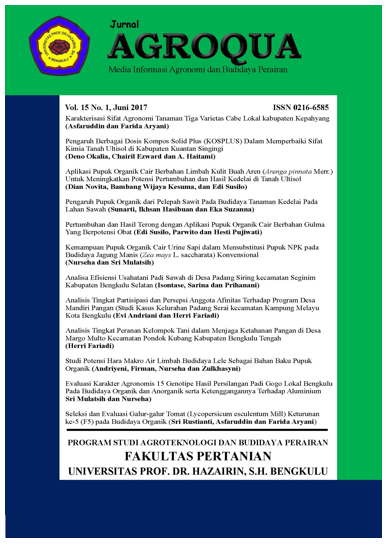ANALISIS KARAKTERISTIK FISIOLOGI TANAMAN KACANG TANAH (Arachis hypogaea L) PADA FREKWENSI PENGOLAHAN TANAH DAN OPTIMALISASI POPULASI TANAMAN
DOI:
https://doi.org/10.32663/ja.v20i2.3075Keywords:
physiological character, peanut, tillage, plant populationAbstract
Peanut production in Indonesia is still low and there has been a decline in peanut production over the last five years. The low production of peanuts in Indonesia is caused by, among other things, varieties, spacing, fertilization, and attacks of pests and diseases. This research was conducted in the experimental garden of the Faculty of Agriculture, Muhammadiyah University of Jember, Jember, East Java, Indonesia. The research was conducted in the form of a field experiment designed in a factorial split plot. Main plot is the frequency of tillage, the main plot is 3 levels, namely: No Tillage, T1: Minimum tillage, T2: Maximum tillage and subplots is population optimization with 3 levels, namely: P1: plant population 830,000 tons/ ha, P2: plant population 714,000 tan/ha, P3: plant population 625,000 tan/ha, each treatment was repeated 3 times. The results showed that the frequency of tillage in peanut plantations had a significant effect on the physiological character of peanut plants. Minimum tillage is the best tillage treatment because it has a significant effect on leaf area index and plant leaf area. Population optimization in peanut plantations has a significant effect on the physiological character of peanut plants. Populations of 830,000 tan/ha and 714,000 tan/ha were the best plant population treatments because they had an effect on plant growth rate and leaf area. The interaction of the frequency of tillage with the peanut population has a significant effect on the physiological character of the peanut plant. The interaction between minimum tillage and peanut population of 830,000 tan/ha was the best treatment combination because it had a significant effect on plant growth rate parameters.
References
Downloads
Published
Issue
Section
License
Authors who publish with this journal agree to the following terms:
- Authors grant the journal right of first publication with the work simultaneously licensed under a Creative Commons Attribution 4.0 Internasional (CC BY 4.0) Licence that allows others to use and share the work with an acknowledgment of the work's authorship and initial publication in this journal.
- The author(s) still hold the copyright of his/her/their work and retain publishing rights without restrictions such as (but not limited to) patent right, lecture, book and reproduce the article for own purposes.
















